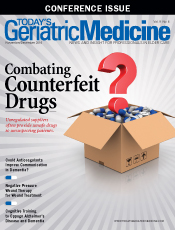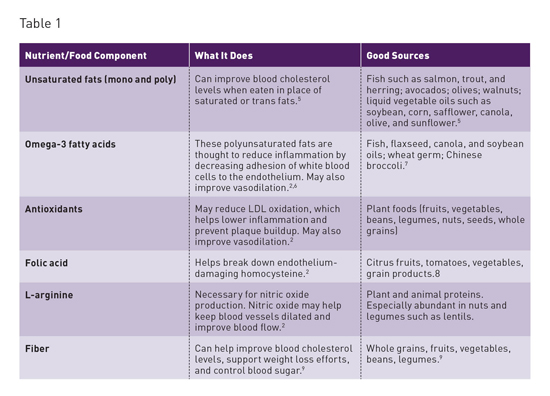
November/December 2016
Nutrition for Arterial Health Many factors contribute to the development of atherosclerosis, but a nutritious dietary pattern can help maintain a clear, flexible, healthy circulatory system. Arteries thicken and harden as we age as a result of the build up of plaque. Since LDL cholesterol is a key component of plaque, there's a focus on lowering serum cholesterol levels to keep arteries clear. The fact is, only one-half of all heart attack and stroke victims have elevated cholesterol levels.1 "Plaque is not just about LDL cholesterol; it's a multifactorial process," says David Becker, MD, a cardiologist with Chestnut Hill Temple Cardiology in Philadelphia. According to Becker, physicians used to believe that plaque built up over a lifetime like rings on a tree. They now know that it's an irritation of the vascular endothelium (the lining of the blood vessels) that causes plaque to form. Arteries and veins are lined with endothelial cells whose job is to keep those blood vessels flexible, supple, and strong. This vascular endothelium controls vasodilation (the widening of blood vessels) and vasoconstriction (the narrowing of blood vessels). It's also responsible for repairing any damage to the blood vessels.2 When the endothelium is irritated or damaged, it mounts an immune response to fix the problem. It's this immune response that ultimately leads to the development of plaque. There are a number of ways in which the endothelium can be damaged; for example, a toxin in tobacco smoke irritates the lining of blood vessels, triggering the formation of plaque, and high blood pressure damages the arteries by overstretching the artery walls, leading to small tears that scar over with plaque.3 In addition to smoking and high blood pressure, an unhealthy diet, diabetes, obesity, lack of exercise, and high cholesterol, triglyceride, blood sugar, and homocysteine levels have all been found to adversely affect endothelial function, whether by impacting plaque formation, vasodilation, or other factors.4 An often overlooked factor in endothelial health is inflammation. According to Becker, "Inflammation is as important or more important than factors like cholesterol level in the development of cardiovascular disease." It's possible for plaque to remain stable, but "if the plaque becomes irritated by inflammation, a scab or clot will form," Becker says. The clot can completely block an artery, causing a heart attack or stroke.3 Risk factors for atherosclerosis may be multifactorial. For example, particles of LDL cholesterol are part of the make-up of plaque, but the presence of oxidized LDL in the blood also causes inflammation.2 The Impact of Diet
Role of Dietary Patterns Putting It Into Practice "MyPlate is a good place to start," says Rena Zelig, DCN, RDN, CDE, CSG, owner of Rena Zelig Nutrition Consulting, LLC, and an assistant professor and director of the master of science in clinical nutrition program at Rutgers School of Health Professions. "Additionally, the two eating patterns that are the most evidence based for overall health, and especially cardiovascular health, are the DASH [Dietary Approaches to Stop Hypertension] and Mediterranean patterns." Zelig recommends using eye-catching, picture-based color handouts and wall hangings of MyPlate, the DASH diet, and/or the Mediterranean diet. Free tip sheets and handouts are available at ChooseMyPlate.gov and other websites. Recommending that colorful fruits and vegetables comprise one-half of each meal and encouraging foods such as beans, lentils, whole grains, and foods rich in mono- and polyunsaturated fats such as olive oil, avocados, nuts, and fatty fish will boost the artery-protecting nutrients in the diet. Different geriatric populations require different approaches. "For residents of long term care facilities, the onus is on staff to design a regular diet that not only tastes good but also meets the guidelines for good health," Zelig says. Those living in retirement communities with dining services expect a range of familiar choices. "It's important to include residents in menu planning and to provide them with basic education so they understand that buying into healthy choices will increase the quality and quantity of their days," Zelig says. Ensuring seniors living in the community make healthy food choices presents a bigger challenge. Planells recommends referral to a registered dietitian (RD) when possible. "RDs have knowledge, resources, and the experience to help guide behavior change," Planells says. "Unfortunately, access to a dietitian for older adults in the community is very rare. Insurance coverage really varies. Medicare covers medical nutrition therapy only for diabetes and chronic kidney disease, so a lot of the basic nutrition education falls to the primary care providers." Other Lifestyle Changes The payoff for these changes can be significant. "Less than 3% of Americans eat a good diet, exercise regularly, are not overweight, and don't smoke," Becker says, "but these people have a very low risk of heart attack and stroke." Getting older adults to alter their dietary patterns can have a positive impact on their arterial health, decreasing their risk for cardiovascular disease. "Change is hard for everybody," Planells says, "and older adults have years of habits to break. But it's never too late. We want to work toward the highest possible quality of life at every age." — Judith C. Thalheimer, RD, LDN, is a registered dietitian and principal of JTRD Nutrition Education Services, LLC, outside Philadelphia.
Eating for Arterial Health • fruits, including citrus and tomatoes; • vegetables, including olives and avocados; • whole grains; • fish, including salmon, trout, and herring; • beans and legumes, including lentils; • nuts, including walnuts; • seeds, including flaxseed; and • vegetable oils, such as olive, canola, soybean, and corn. — JCT References 2. Brown AA, Hu FB. Dietary modulation of endothelial function: implications for cardiovascular disease. Am J Clin Nutr. 2001;73(4):673-686. 3. Caswell J. When risk factors unite. Stroke Connection. 2005;18-23. 4. Sainani GS. Role of diet, exercise and drugs in modulation of endothelial cell dysfunction. J Assoc Physicians India. 2012;60:14-19. 5. Know your fats. American Heart Association website. http://www.heart.org/HEARTORG/Conditions/Cholesterol/PreventionTreatmentofHighCholesterol/Know-Your-Fats_UCM_305628_Article.jsp. Updated April 21, 2014. Accessed July 11, 2014. 6. Inflammation: the leukocyte adhesion cascade. University of Virginia Biomedical Engineering website. http://bme.virginia.edu/ley/ 7. Foods highest in total omega-3 fatty acids in vegetables and vegetable products. SELF NutritionData website. http://nutritiondata.self.com/foods-011140000000000000000-1.html?. Accessed July 1, 2014. 8. Heart and Stroke Encyclopedia: folic acid and cardiovascular disease. American Heart Association website. http://www.heart.org/HEARTORG/Encyclopedia/Heart-Encyclopedia_UCM_445084_ 10. Eckel RH, Jakicic JM, Ard JD, et al. 2013 AHA/ACC guideline on lifestyle management to reduce cardiovascular risk: a report of the American College of Cardiology/American Heart Association Task Force on Practice Guidelines. J Am Coll Cardiol. 2014;63(25 Pt B):2960-2984. 11. Sallam N, Laher I. Exercise modulates oxidative stress and inflammation in aging and cardiovascular diseases. Oxid Med Cell Longev. 2016;2016:7239639. |

